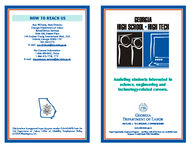HOW TO REACH US
Ron Williams, State Director Georgia Department of Labor
Rehabilitation Services Suite 650, Sussex Place 148 Andrew Young International Blvd., N.E. Atlanta, Georgia 30303-1751
404-232-3775 E-mail: ron.williams@dol.state.ga.us
For General Information: 1-866-489-0001, Voice 1-866-373-7778, TTY
E-mail: vrpcustomer-service@dol.state.ga.us
This brochure is supported in part by grant number E-9-4-2-0070 from the U.S. Department of Labor, Office of Disability Employment Policy, (ODEP) Washington, D.C.
GEORGIA
HIGH SCHOOL HIGH TECH
Assisting students interested in science, engineering and technology-related careers.
GEORGIA DEPARTMENT OF LABOR
MICHAEL L. THURMOND, COMMISSIONER www.dol.state.ga.us
Equal Opportunity Employer/Program l Auxiliary Aids & Services Are Available Upon Request To Individuals With Disabilities
WHAT IS HIGH SCHOOL/HIGH TECH?
High School/High Tech (HS/HT) is a community based enrichment initiative for high school students with disabilities. It is designed to develop career opportunities and provide activities that will spark an interest in high technology career fields, and to encourage students to pursue higher education.
WHAT ARE THE PROGRAM GOALS?
National Goals l Promote effective practices among sites and policymaking
organizations
l Build partnerships with public and private organizations to promote technology based careers for young people with all types of disabilities
l Build state-based collaboratives
l Document outcomes to demonstrate effectiveness of HS/HT Sites
State and Local Goals l To ensure youth with disabilities are exposed to careers in high
demand and high tech industries
l To use the HS/HT design to provide both in-school and extracurricular opportunities for youth with disabilities
l To improve education and training outcomes for youth with disabilities
CORE ELEMENTS AND DESIGN FEATURES
Preparatory experiences - The preparatory experiences design feature includes activities and services undertaken by the youth while at the program or education site. The activities under this category include career assessment, opportunity awareness, and work-readiness skills.
Connecting activities - This feature examines the connecting activities necessary to assist HS/HT participants' transition to their next phase in life - one that will hopefully provide for economic self-sufficiency. The focus is on services and activities which include tutoring to improve academic performance, mentoring, assistive technology to address accommodation needs, and transportation. Youth participating in HS/HT programs must connect with other agencies as they pursue options in postsecondary education and high-tech careers.
Work-based experiences - Work-based experiences include a range of activities that build up to on-the-job experiences. These experiences include site visits, job shadowing, internships, entrepreneurial ventures, and actual paid employment. In all cases, the lessons learned during the work-based experiences should be reviewed to ensure that youth make a connection between what they are learning in the HS/HT program and what is expected in the working world.
Youth development and leadership - Youth development and leadership activities help young people become self-sufficient and productive members of society. The components under this design feature include providing supportive adults, developing independent decision-making skills, encouraging service learning, and promoting the development of self-determination and selfadvocacy skills.
